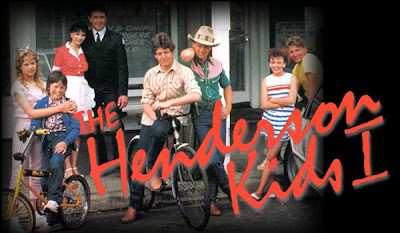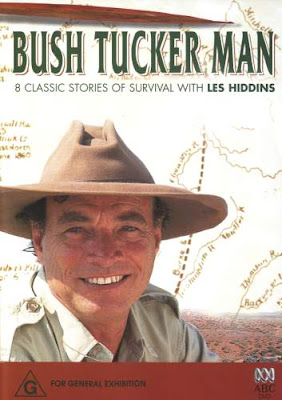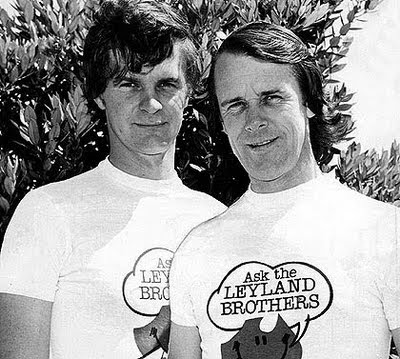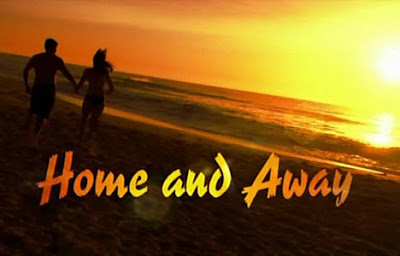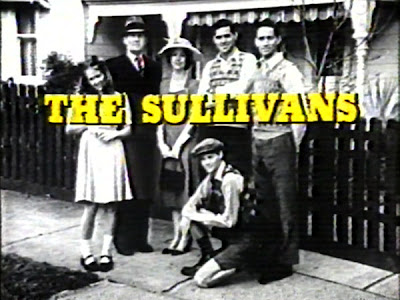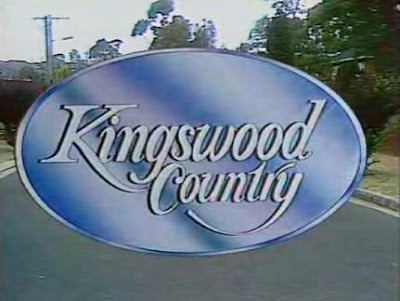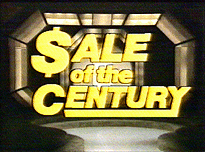Monday, May 31, 2010
Perfect Match
Perfect Match is an Australian dating game show based on the format of The Dating Game and Blind Date. Perfect Match was produced by the Reg Grundy Organisation.
It originally aired on Network Ten for 30 minutes most weekdays from 5:30pm between 1984 and 1989. The format was revived in Australia for subsequent programs Blind Date in 1991, and Perfect Match on the Seven Network in 2002.
Carson's Law
Carson's Law is an Australian television series made by Crawford Productions for the Ten Network between 1983 and 1984. The series was a period piece set in the 1920s and starred Lorraine Bayly as progressive solicitor Jennifer Carson. The episodes revolved around the cases taken on by Jennifer, and the various personal intrigues of her family.
Carson's Law was noted for its quality scripts and period production values, however although the programme was very popular in Melbourne where the series was based and filmed, it did not succeed in Sydney. Attempts to revamp the series to make it appeal more to Sydney audiences eventually alienated the programme's core audience, and it was cancelled in 1984 after 184 episodes. Carson's Law was bought by two members of the UK ITV network. Yorkshire Television showed a considerable amount of episodes on Thursdays at 1.30pm during 1984 while Television South West screened a slightly lower amount in their 6.35pm slot on Tuesdays during 1984.
Monday, May 24, 2010
Comedy Company
The Comedy Company was an Australian comedy television series first aired from 16 February 1988 until about 11 November 1990 on Network Ten, Sunday night and was created and directed by Ian McFadyen, and co directed and produced by Jo Lane. The show largely consisted of sketch comedy in short segments, much in the tradition of earlier Sketch comedy shows, The Mavis Bramston Show, The Naked Vicar Show, Australia You're Standing In It, and The D-Generation. The majority of the filming took place in Melbourne, Victoria. The show had a significant effect on Australian culture, particularly on Australian youth. The Australian adoption of the word "Bogan" was first used in its existing context by the famous The Comedy Company character, Kylie Mole.
Friday, May 14, 2010
Henderson Kids
The Henderson Kids was an Australian television series made by Crawford Productions for Network Ten between 1985 and 1987. It was created and storylined by Roger Moulton, who also wrote 5 episodes in the first series and 2 episodes in the second series.
The series follows a teenage brother and sister, Steve (Paul Smith) and Tamara (Nadine Garner). They are forced to leave the city and move to the country to live with their uncle Mike (Nicholas Eadie) after their mother Alice (Diane Craig) is hit by a truck and killed. Mike is a police officer in the fictional town of Haven Bay.
The Henderson kids making a new life in Haven Bay and making friends with the local gang. They were Ted Morgan (Ben Mendelsohn), Colin "Cowboy" Clarke (Mark Hennessy), Charlotte "Char" Kernow (Kylie Minogue) and Brian "Brains" Buchanan (Bradley Kilpatrick).
Steve and Tamara defend the family land, Hendersons' Point, against the schemes of ruthless businessman Ashley Wheeler (Peter Whitford). To compound matters, Steve falls in love with Wheeler's gorgeous daughter Sylvia (Annie Jones).
Several well known actors played guest roles in the series. They included Tottie Goldsmith, Kevin Harrington, Peter O'Brien, Stefan Dennis, and Jane Hall who all went on to appear in Neighbours. Antoinette Byron also had a role in the series.
The Haven Bay set footage was filmed in Birregurra, Victoria
Fat Cat & Friends
Fat Cat and Friends was an Australian children's television show starring Fat Cat, an orange anthropomorphic cat who wears red braces, a blue bow tie and a green bowler hat. The show was similar in concept to Here's Humphrey featuring Humphrey B. Bear. It was produced in the studios of Channel 10 Adelaide and it survived the 1987 frequency switch of channels 10 & 7 in Adelaide.
The show ran on the 0-10 Network (as it was then known) from 1972 until 1987, then on the Seven Network until it was cancelled in 1992 after the Australian Broadcasting Tribunal claimed that the program was not educational enough and was "not clearly defined and might confuse the young". There was also a question of gender- namely, that Fat Cat did not appear to have one. The character being mute was also a clear issue despite the precedent of Humphrey B. Bear.
Despite cancellation, Fat Cat still appears on Perth television screens as the mascot of Seven Perth's highly successful Telethon fundraising organisation. He also says goodnight to children on television at 7.30 each night.
Fat Cat was played by Ralf Hadzic, who currently operates wine tours in Adelaide with an organisation called "Life is a Cabernet". The character had earlier been played by a male friend of the show's musician, singer Patsy Biscoe.
Initially slated for release as a sidekick to Fat Cat, the character of 'Stringbean' was originally played in the first month of screening by veteran comedic actor 'Nudge McGee'.
A Cry In The Dark - Lindy Chamberlain Story
The film was released less than two months after the Chamberlains finally were exonerated by the Northern Territory Court of Appeals of all charges filed against them
Thursday, May 13, 2010
Bush Tucker Man
Major Leslie James (Les) Hiddins AM (born August 13, 1946 in Brisbane, Queensland), aka "The Bush Tucker Man" is a retired Australian Army soldier and war veteran, who is best known for his love and knowledge of the Australian bush. Hiddins is recognised by his distinctively modified Akubra hat and big grin.
As a soldier with the Australian Army, Hiddins did two tours of duty in Vietnam between 1966 and 1968, the first as a forward scout in the infantry. In 1987 he was awarded a Defence Fellowship to research survival in northern Australia. He was the principal author of the Australian Army's Combat Survival manual (1987) and was awarded Member of the Order of Australia (AM) in 1987
This research turned into a hit TV series The Bush Tucker Man. The series involves Hiddins driving around in a Land Rover Perentie, then in later episodes a Defender 110 with his trademark hat, finding and describing native Australian bush food or "Bush Tucker". Les appeared in two ABC TV series of Bush Tucker Man, and the series Bush Tucker Man - Stories of Survival. He also appeared in the TV documentaries Pandora - in the Wake of the Bounty and The Batavia. His other publications are Bush Tucker Man - Stories of Exploration and Survival (1996), Bush Tucker Man - Tarnished Heroes (1997), Explore Wild Australia with the Bush Tucker Man (1999), Bush Tucker Fieldguide (2002).
In The Bush With Malcolm Douglas
In 1964, Malcolm Douglas, then just 23 years old, and a mate, set off on a six-month trip around Australia. Six months turned into four years. It was a journey that shaped Malcolm's future. And as they travelled and explored, they filmed their adventures.[2] The Film later turned into the documentary 'Across the Top', Which still holds the rating record for a documentary on Australian television.[3] Since then he has produced over 50 Documentaries and Films for Channel Seven and Channel Nine.[4] He is also known as the "Barefoot Bushman".
His 2008 produced 6-part series, In The Bush With Malcolm Douglas, aired in 2009 on Channel Seven to high ratings on Saturday nights, winning its timeslot 4 out of the 6 weeks.[5] Based on these ratings, after the conclusion of the series Channel Seven will replay another of his documentary series In Search of the Big Barra.
Ask The Leyland Brothers
Mike (1941– September 14, 2009 and Mal Leyland (born 1945), also known as The Leyland Brothers, were Australian explorers and documentary film-makers, best known for their popular television show, Ask the Leyland Brothers. The show ran on Australian television from 1976 until 1984
The New Price Is Right - 1984
The New Price Is Right aired on Seven Network from 1981-1986 with host Ian Turpie and announcer John Deeks. In 1984, the show introduced a "carry-over" format with returning champions. Up to that point, the format of the show consisted of three pricing games, the Showcase Playoff, and the Showcase. The new format replaced the third game with the Showcase Showdown from the American version, with 100 earning a bonus prize. The winner faced the champion in the Showcase Playoff, whose winner advanced to the Showcase.
Price was revived in 1989 for an hour-long version, again hosted by Turpie airing Saturday nights on Network Ten as part of Network Ten's attempted revamp that year; however, it only lasted 12 episodes. The format resembled the US version, with three games, then a Showcase Showdown, then repeat. The two Showdown winners then competed in the Showcase Playoff, with the winner advancing to the Showcase.
Family Feud - 1982
Family Feud was an Australian game show based on the American show of the same name. It ran on the Nine Network from 1977-1984, and on the Seven Network from 1989-1996.
Representatives of the family are posed questions that have already been answered by 100 people. An answer is considered correct if it is one of the concealed answers on the game board, or judged to be equivalent. More points are given for answers that have been given by more people in the survey (one point per person). Answers must have been given by at least two of the 100 people in order to be included on the board. There are four members on each team.
Examples of questions might be "Name a famous George", "Tell me a popular family vacation spot", "Name something you do at school", or "Name a slang name for policemen". At least two people among the survey respondents must give an answer for it to appear as one of the possibilities.
The participants are not asked questions about what is true or how things really are. Instead, they are asked questions about what other people think are true. As such, a perfectly logical answer may be considered incorrect because it failed to make the survey (e.g.: for the question about Georges, George Jones was a popular country singer, but if his name was not given by at least two people it would be considered wrong).
Representatives of the family are posed questions that have already been answered by 100 people. An answer is considered correct if it is one of the concealed answers on the game board, or judged to be equivalent. More points are given for answers that have been given by more people in the survey (one point per person). Answers must have been given by at least two of the 100 people in order to be included on the board. There are four members on each team.
Examples of questions might be "Name a famous George", "Tell me a popular family vacation spot", "Name something you do at school", or "Name a slang name for policemen". At least two people among the survey respondents must give an answer for it to appear as one of the possibilities.
The participants are not asked questions about what is true or how things really are. Instead, they are asked questions about what other people think are true. As such, a perfectly logical answer may be considered incorrect because it failed to make the survey (e.g.: for the question about Georges, George Jones was a popular country singer, but if his name was not given by at least two people it would be considered wrong).
Agro's cartoon connection
Agro's Cartoon Connection was an Australian children's television show that aired on the Seven Network from 1989 to 1997. Shown on weekday mornings, it was primarily hosted by Agro, a puppet played by comedian Jamie Dunn.
Over the years the show had a number of co-hosts including Ann-Maree Biggar, Terasa Livingstone, Holly Brisley, Michael R Gibson and guest hosts Ian Calder and Stacey Thomson.
It followed on from a show called Cartoon Connection which had been hosted for many years previously by Michael Horrocks and Alex Wileman, Wileman went on to do New South Wales lottery broadcasts.
The show consisted of playing a variety of cartoons including Teenage Mutant Ninja Turtles, Popeye, various Hanna-Barbera cartoons, Samurai Pizza Cats and Sailor Moon while including small editorials presented between the cartoons in a variety of segments. One such example included Ian Calder appearing in a regular segment acting as a character, one of his more popular being Crikey the Clown where he would walk around the streets of Brisbane in an aggressive manner asking questions to anyone he met.
Other shows presented during the series' run included G.I. Joe, He-Man, Robotech, Power Rangers Zeo, The Bots Master, Masked Rider, Sonic the Hedgehog, Scooby Doo, The Mask and Mega Man. The Sunday morning edition of the program ran under the name The Super Sunday Show and included skits performed by the regulars, as well as presenting the UK sci-fi program UFO.
Notably the show's humour was sometimes provocative but always done in a way that would escape the notice of the show's primary audience of children. The program was criticized in Parliament for including product sponsorship within the program itself, rather than simply running commercial breaks.
In its final years the show lost in the ratings to its competitor Cheez TV, causing the Seven Network to cut its running time and funding until it was cancelled.
Mr Squiggle
Mr. Squiggle was created by Norman Hetherington, and the show first aired on 1 July 1959. Hetherington voiced all the show's puppets, while his wife Margaret wrote the scripts. The last episode went to air just over 40 years later on 9 July 1999.
Mr. Squiggle was helped by a human female assistant in all of the show's incarnations; they included Miss Gina (Gina Curtis), Miss Pat (Pat Lovell), Miss Jane (Jane Fennell), and later series featured Roxanne (Roxanne Kimmorley) and Rebecca (Rebecca Hetherington, Hetherington's daughter).
The show has been presented in many formats, from five minute slots to a one-and-a-half hour variety show featuring other performers, and has had several name changes, originally airing as Mr. Squiggle and Friends. Yet the basic premise of the show remained the same: children wrote in with their "squiggles" and Mr. Squiggle would turn them into a recognisable drawing by connecting lines with his pencil nose. More often than not, the picture would be drawn upside down (Hetherington manipulated the puppet from above by viewing the drawing upside down), and then Mr. Squiggle would gleefully declare: "Upside down! Upside down!" – asking his assistant to turn the picture the right way up and reveal the completed drawing.
Mr Squiggle was a cheery, scatter-brained character who would often be distracted and would occasionally go for "space-walks", and his assistant would need to calm him down to get him to focus on the task of drawing.
Other puppet characters that appeared in the show included:
Blackboard, the grumpy blackboard that Mr. Squiggle used for an easel, whose catchcries were "Oh Hu-rry u-p" and "Hmmph and double hmmph".
Gus the Snail, who had a TV for a shell and later, a flower pot.
Bill the Steam Shovel, who liked to tell corny jokes and belched steam out of his "nose" when he laughed.
Shirl's Neighbourhood
Shirl's Neighbourhood was an Australian afternoon children's television series aired on the Seven Network between 1979 and 1983. The half-hour show featured former Skyhooks frontman Graeme "Shirley" Strachan and co-host Liz Rule alongside a cast of characters including Norm The Kangaroo, Ol' Possum, Claude The Crow, Stanley The Snake, Greenfinger the Garden Gnome, Yippee the Bunyip, Bartholomew the Sheep and a band of monkeys. Franciscus Henri appeared in the show as a regular, both as himself presenting musical segments and as "Professor Henri" in comical sketches. He left the show in October 1980.
Norm the Kangaroo was played by Don Bridges. The other characters were puppets created and brought to life by Ron Mueck. Shirl's Neighbourhood was produced by Jennifer Hooks and Richard Bence of Puppetstuff. It ran from 1979 till 1983 and clocked up over 900 episodes. Jennifer Hooks later went on to head Film Victoria and Cinemedia.
The show was very popular with kids and adults alike. This was due mainly to the character of Claude the Crow. Claude had a slightly more cynical view of the world than the other characters, and adults could identify with this.
Home and Away - Pilot episode 1
Home and Away is an Australian soap opera that has been produced in Sydney by the Seven Network since July 1987. It premiered in January 1988 and is the second longest-running drama on Australian television, winning more than 30 Logie Awards
The show initially focused on the characters of Pippa (Vanessa Downing/Debra Lawrance) and Tom Fletcher (Roger Oakley), who ran the Summer Bay Caravan Park and lived there with a succession of foster children, most notably their adopted daughter Sally, played by Kate Ritchie.
The Sullivans - episode 1 & 2
The Sullivans is an Australian drama television series produced by Crawford Productions which ran from 1976 until 1983. The series told the story of an average middle-class Irish-Australian Melbourne family and the effect World War II had on their lives. It was a consistent ratings success in Australia, and also became popular in the Netherlands, United Kingdom, Ireland and New Zealand.
The story began in 1939, with the declaration of war against Germany. From the outset the series focused on the Sullivan family of 7 Gordon Street, Camberwell, Victoria, along with neighbourhood friends, relatives, and associates. The majority of show's storylines related to the war, focussing on either the fighting itself or its impact on the Sullivan family. Scenes of battles in northern Africa, Greece, Crete, the Netherlands, England, New Guinea and Malaya were all filmed in or around Melbourne.
The Sullivans was renowned for its high production standards. The programme's researchers went to great lengths to ensure both historical and cultural accuracy. Many scenes were timestamped and the scripts referenced actual military developments and events of the time, such discussion of specific battles, sporting results and cinematic releases. Authentic 1930s furniture was located and used on sets, while kitchen pantries and the corner store were stocked with packaged goods of the era.
A Country Practice - episode 1
A Country Practice was one of the longest-running Australian television drama series. It ran on the Seven Network for 1,058 episodes from 18 November 1981 to 22 November 1993. It was produced in ATN-7's production facility at Epping, Sydney. It also ran from April to November 1994 for 30 episodes on Network Ten. The Channel Seven series was also filmed on location in Pitt Town, (outskirts of Northwest Sydney) while the Channel Ten series was filmed on location in Emerald, Victoria.
Though sometimes considered a soap opera, the storylines of the show's two one-hour episodes screened over any one week formed a self-contained narrative block. The storylines were meant to have a primary appeal to adult and older youthful audiences, and in particular they had greater appeal to children from middle class backgrounds.[1] As it did not have the open ended narrative of a traditional soap opera, it was technically a series [2]. Nevertheless many storylines were developed as sub plots for several episodes before becoming the focus of a particular week's narrative block. Overall, the programme "so emphasised the ongoing storylines of its major characters as to make the distinction between series and serial more or less meaningless" [2].
In addition to being broadcast in Australia, it also ran on the ITV network in the United Kingdom, as well as in many European countries and Hong Kong. It was also carried on a variety of Canadian stations, both during the show's lifetime and after. It was estimated that at its height, the show received a worldwide audience of five to six million each week.
The show followed a medical practice in the small fictional New South Wales country town of Wandin Valley. The show's stories focused on the staff of the practice and the hospital and their families, and through weekly guest characters - frequently patients served by the practice - various social and medical problems were explored. The series examined such topical issues as youth unemployment, suicide, drug addiction, HIV/AIDS, and terminal illness as well as Aborigines and their place in modern Australian society. Apart from its regular rotating cast of characters, mainly among the younger personnel, A Country Practice also had a cast of semi-regulars who would make appearances as the storylines permitted.
A Country Practice has also become well-known for its number of guest stars appearances, including Baz Luhrmann, Smokey Dawson, John Meillon, Sir Robert Helpmann and even the Australian Prime Minister Bob Hawke made a cameo appearance in 1986. Nicole Kidman, Toni Collette and Simon Baker also had guest-roles in the series before going on to international fame.
The series is also the third most successful series in the history of the Logie Awards having won 29 times. Brian Wenzel was the first actor to win such an Honour for his role as Sergeant Frank Gilroy. By the end of the series Brian Wenzel and Shane Porteous were the only original cast members.
Sons and Daughters - episode 1
Sons and Daughters was a Logie Award winning Australian soap opera created by Reg Watson and produced by the Reg Grundy Organisation. It screened on the Seven Network in an early evening timeslot, running from 18 January 1982 until 19 August 1987. The series commenced in Melbourne with the first three episodes screened in a 90 minute format on Monday, 18 January 1982 at 7pm. A repeat run on the Seven Network in Australia ran in October 2006 but ended in March 2007; however beginning from July 2008 it has started up again, picking up where it left off every Thursday night at around midnight. Additionally, the Seven Network's digital channel 7TWO has begun airing the series from the very beginning starting November 4, 2009 every weekday at 9am. A DVD marking the 25th Anniversary of Sons and Daughters was released in October 2006.
Prisoner - Cell Block H episode 1
Prisoner is an Australian television soap opera which was set in the Wentworth Detention Centre, a fictional women's prison. The series was produced by the Reg Grundy Organisation and ran on Network Ten for 692 episodes from 27 February 1979 to 16 December 1986.
The series was inspired by the 1970s British television drama Within These Walls, which had achieved moderate success in Australia. Because of an injunction brought by UK-based ATV, which considered the title too similar to their own series The Prisoner, it was originally not possible for overseas broadcasters to screen the show under the name Prisoner which necessitated a name change. It was known as Prisoner: Cell Block H in the UK and the United States (though this extended title was not shown onscreen), and as Caged Women in Canada.
Kingswood Country - Aerial Warfare
While some condemned its racist and sexist humour, this was often simply a plot device to show the bigotry of the main character, Edward Melba "Ted" Bullpitt (Ross Higgins), a white Australian, conservative, bigoted, Holden Kingswood-loving putty factory worker and WWII veteran who recalls his difficult childhood in ever more exaggerated ways.
He lives for three things: his beloved chair in front of the TV, his unsuccessful racing greyhounds and his worshipped Holden Kingswood car (late in the show's run Ted traded-in the Kingswood, which had gone out of production around the time the series began, for Holden's replacement mid-range family car, the Commodore). His long-suffering wife, the vague and dithering Thelma (Judi Farr), was cast as a traditional housewife trapped by Ted's conservative family views, but she often got her own back on Ted.
Humour was generated by the conflict of Ted's traditional views and his children's progressive nature. For example, his son Craig (Peter Fisher) is portrayed as a sexually rampant medical student and is referred to as an "Al Grassby Groupie", a reference to a progressive politician of the time. His daughter, Greta (Laurel McGowan), is portrayed as a feminist and is married to Bruno (Lex Marinos), the son of Italian immigrants, to which Ted strongly objects (often referring to him as a "bloody wog"). Other politically-incorrect humor includes Ted's references to Neville, the concrete Aboriginal garden statue.
At other times, humour was based on the more traditional comedic methods of poorly thought-out schemes of Ted's (usually get-rich-quick); class differences (between the suburban Bullpitts and Ted's upwardly-mobile sister-in-law Merle) and simple misunderstandings leading to a chain of humorous events.
Curiosity Show
The Curiosity Show was an Australian educational children's television show produced from 1972 to 1990, hosted by Prof. Rob Morrison and Dr. Deane Hutton. The show was produced by Banksia Productions in South Australia for the Nine Network. 149 episodes were produced.
From 1972 to 1980 the format was a 60 minute show presented by Rob Morrison, Deane Hutton, Ian Fairweather. The emphasis was on science but also included general craft and music. Producers were Neil Smith, Kate Kennedy White (1978-79) and James Lingwood (1980).
From 1980 the show was reduced to 30 minutes, presented by Morrison and Hutton, with emphasis on science, nature and the environment.
The Curiosity Show won the coveted Prix Jeunesse in 1982 voted by peers from around the world as the best factual program for children.
The programme placed a strong emphasis on practical demonstrations of various science topics, and included activities such as floating a ping-pong ball on a stream of air, setting off a room full of mouse traps, and freezing objects with liquid nitrogen.
Many segments described a sequence of steps to build something out of common household materials, which invariably ended with the phrase "here's one I prepared earlier". Hutton's catchphrase, after presenting a hypothesis he postulates the audience may be curious about, was to declare "well I'm glad you asked," before responding to the hypothesis. The use of household materials was initially due to the very low budget allocated for production, but this proved popular with the young audience who could easily replicate the demonstrations at home.
Hey Hey It's Saturday (March 1984)
Hey Hey It's Saturday is a long running variety television program on Australian television. It ran for 27 years (there was a recess in 1978), debuting on the Nine Network on 9 October 1971 and broadcasting its last episode on 20 November 1999. Its host throughout its entire run was Daryl Somers, who would later become executive producer of the program. Gavin Disney, the show's co-creator and original producer, left the series in the 1980s and Somers then jointly formed his own production company, Somers Carroll Productions with on-screen partner Ernie Carroll, the performer of Daryl's puppet sidekick Ossie Ostrich.
On 25 July 2009, the Nine Network announced the show would return for two reunion specials in late 2009 and hinted if they rated strongly, the show could return full time.[2] The first reunion show aired on 30 September 2009 and the second on 7 October. On 7 December 2009, it was announced that the show was planned to return in 2010 with an estimated run of 20 episodes. On 26 March 2010 it was announced that the new series of Hey Hey It's Saturday was to commence on 14 April 2010.[3] During the 2010 premiere on 14 April, it was indicated that the 20 episode run would be split into two groups, with a break between them, and the second group would be aired at an unspecified period of time later in 2010.
Sale of the Century
$ale of the Century was an Australian game show that aired on the Nine Network from 14 July 1980 – December 2001. Tony Barber hosted an early version of Sale of the Century under the title of Temptation from 1970–1976, and was also the initial host of Sale, replaced by Glenn Ridge in 1991. Hostesses over the years have included Victoria Nicholls, Delvene Delaney, Alyce Platt, Jo Bailey, Nicky Buckley and Karina Brown. Pete Smith was Sale's announcer for the majority of its run.Ron Neate was announcer for only the first ten episodes in 1980 before Smith took over.
Blankety Blanks
Blankety Blanks was a popular Australian game show based on the American game show Match Game. It was hosted by Graham Kennedy on Network Ten. It ran from 1977-1978.
Regular panelists were Ugly Dave Gray, Noeline Brown, Carol Raye and Stuart Wagstaff. Other panelists included Noel Ferrier, Belinda Giblin, Abigail, Nick Tate, Tommy Hanlon Junior, Dawn Lake, Jon English, Wendy Blacklock, Barry Creyton, Peta Toppano, Mark Holden and John Paul Young.
Blankety Blanks had a two-season run from 1977 to 1978. It was screened at a rate of five, thirty-minute episodes each week, stripped across an early evening timeslot. It was broadcast at 7.30 PM in 1977, and at 7.00 PM in 1978.[1]
Kennedy won a TV Week Gold Logie Award in 1978 for Most Popular Personality On Australian Television. When Kennedy succumbed to laryngitis, announcer Don Blake was forced to host the show for an episode.
Welcome to Oldschool Aussie Tv
Welcome to Oldschool Aussie Tv
a blog that looks back at yester year Australian Tv.
a blog that looks back at yester year Australian Tv.
Subscribe to:
Posts (Atom)





